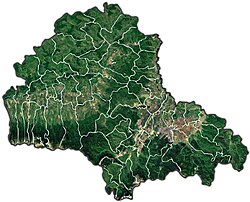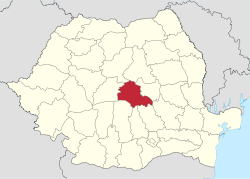Brașov County
|
Brașov County Județul Brașov |
||
|---|---|---|
| County | ||

Administrative map
|
||
|
||
 Location of Brașov County in Romania |
||
| Coordinates: 45°47′N 25°17′E / 45.79°N 25.28°ECoordinates: 45°47′N 25°17′E / 45.79°N 25.28°E | ||
| Country |
|
|
| Development region1 | Centru | |
| Historic region | Transylvania | |
| Capital city (Reședință de județ) | Brașov | |
| Government | ||
| • Type | County Board | |
| • President of the County Board | Aristotel Căncescu (National Liberal Party) | |
| • Prefect2 | Adriana Donțu | |
| Area | ||
| • Total | 5,363 km2 (2,071 sq mi) | |
| Area rank | 25th in Romania | |
| Population (2011 census) | ||
| • Total | 549,217 | |
| • Rank | 13th in Romania | |
| • Density | 100/km2 (270/sq mi) | |
| Time zone | EET (UTC+2) | |
| • Summer (DST) | EEST (UTC+3) | |
| Postal Code | 50wxyz3 | |
| Area code(s) | +40 x684 | |
| Car Plates | BV5 | |
| GDP | US$ 6.63 billion (2008) | |
| GDP/capita | US$ 11,262 (2008) | |
| Website |
County Board County Prefecture |
|
|
1The developing regions of Romania have no administrative role. They were formed just to attract funds from the European Union 2 as of 2007, the Prefect is not a politician, but a public functionary. He (or she) is not allowed to be a member of a political party, and is banned to have any political activity in the first six months after the resignation (or exclusion) from the public functionary corps 3w, x, y, and z are digits that indicate the city, the street, part of the street, or even the building of the address 4x is a digit indicating the operator: 2 for the former national operator, Romtelecom, and 3 for the other ground telephone networks 5used on both the plates of the vehicles that operate only in the county limits (like utility vehicles, ATVs, etc.), and the ones used outside the county |
||
Brașov (Romanian pronunciation: [braˈʃov]) is a county (județ) of Romania, in Transylvania, with the capital city at Brașov. The county incorporates within its boundaries most of the Medieval "lands" (țări) Burzenland and Făgăraș.
In Hungarian, it is known as Brassó megye, and in German as Kreis Kronstadt. During Austro-Hungarian administration, from 1876 to 1918, there was a county with similar name (see: Brassó County).
In October 20, 2011, it had a population of 549,217 and the population density was 100/km².
Traditionally the Romanian population was concentrated in the West and South-West of the County, the Hungarians are in the East part of the county, and the Germans were in the North and around Brașov city.
The county has a total area of 5,363 km².
The South side comprises the Carpathian Mountains (Southern Carpathians and Eastern Carpathians) with Făgăraș Mountains, Bucegi Mountains, Piatra Mare Mountains, Piatra Craiului Mountains and the Postăvarul Massif. In the east side there is the Brașov Depression, and in the west side there is the Olt River valley. Between them there are the Perșani Mountains. The North and West side of the county is crossed by the Olt River.
...
Wikipedia

